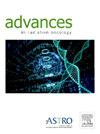利用超高质量四维磁共振成像估计肝癌放射治疗的内靶体积
IF 2.7
Q3 ONCOLOGY
引用次数: 0
摘要
目的准确的内靶体积(ITV)估算是肝癌放射治疗有效、安全的基础。本研究评估了超高质量四维磁共振成像(UQ 4D-MRI)技术对ITV估计的临床价值。方法和材料UQ 4D-MRI技术将运动信息从低空间分辨率动态体积MRI映射到用于放射治疗计划的高分辨率三维MRI上。它通过运动幻影和13名肝癌患者的数据得到验证。将UQ 4D-MRI (ITV4D)产生的ITV与各向同性扩张(ITV2 mm和itv5mm)和传统4d计算机断层扫描(基于计算机断层扫描的ITV, ITVCT)测量的结果进行比较。结果扫描结果显示,UQ 4D-MRI与单排二维电影MRI的位移测量值相差约5%。在患者研究中,UQ 4D-MRI上肿瘤的最大上下位移与单排二维电影成像相比无显著差异(P = .985)。基于ct的ITV与ITV4D无显著差异(P = .72),而itvv2 mm和ITV5 mm的体积高估率分别为29.0% (P = .002)和120.7% (P <;.001),分别与ITV4D比较。结论suq 4D-MRI能准确评估肝脏肿瘤的运动特征,为制定放射治疗计划提供准确的影像学描述。尽管基于人工智能的描述和患者呼吸模式的变化存在不确定性,但UQ 4D-MRI在捕获肿瘤运动轨迹方面表现出色,有可能提高治疗计划的准确性并减少肝癌放射治疗的边缘。本文章由计算机程序翻译,如有差异,请以英文原文为准。
Internal Target Volume Estimation for Liver Cancer Radiation Therapy Using an Ultra Quality 4-Dimensional Magnetic Resonance Imaging
Purpose
Accurate internal target volume (ITV) estimation is essential for effective and safe radiation therapy in liver cancer. This study evaluates the clinical value of an ultraquality 4-dimensional magnetic resonance imaging (UQ 4D-MRI) technique for ITV estimation.
Methods and Materials
The UQ 4D-MRI technique maps motion information from a low spatial resolution dynamic volumetric MRI onto a high-resolution 3-dimensional MRI used for radiation treatment planning. It was validated using a motion phantom and data from 13 patients with liver cancer. ITV generated from UQ 4D-MRI (ITV4D) was compared with those obtained through isotropic expansions (ITV2 mm and ITV5 mm) and those measured using conventional 4D-computed tomography (computed tomography-based ITV, ITVCT) for each patient.
Results
Phantom studies showed a displacement measurement difference of <5% between UQ 4D-MRI and single-slice 2-dimensional cine MRI. In patient studies, the maximum superior-inferior displacements of the tumor on UQ 4D-MRI showed no significant difference compared with single-slice 2-dimensional cine imaging (P = .985). Computed tomography-based ITV showed no significant difference (P = .72) with ITV4D, whereas ITV2 mm and ITV5 mm significantly overestimated the volume by 29.0% (P = .002) and 120.7% (P < .001) compared with ITV4D, respectively.
Conclusions
UQ 4D-MRI enables accurate motion assessment for liver tumors, facilitating precise ITV delineation for radiation treatment planning. Despite uncertainties from artificial intelligence-based delineation and variations in patients’ respiratory patterns, UQ 4D-MRI excels at capturing tumor motion trajectories, potentially improving treatment planning accuracy and reducing margins in liver cancer radiation therapy.
求助全文
通过发布文献求助,成功后即可免费获取论文全文。
去求助
来源期刊

Advances in Radiation Oncology
Medicine-Radiology, Nuclear Medicine and Imaging
CiteScore
4.60
自引率
4.30%
发文量
208
审稿时长
98 days
期刊介绍:
The purpose of Advances is to provide information for clinicians who use radiation therapy by publishing: Clinical trial reports and reanalyses. Basic science original reports. Manuscripts examining health services research, comparative and cost effectiveness research, and systematic reviews. Case reports documenting unusual problems and solutions. High quality multi and single institutional series, as well as other novel retrospective hypothesis generating series. Timely critical reviews on important topics in radiation oncology, such as side effects. Articles reporting the natural history of disease and patterns of failure, particularly as they relate to treatment volume delineation. Articles on safety and quality in radiation therapy. Essays on clinical experience. Articles on practice transformation in radiation oncology, in particular: Aspects of health policy that may impact the future practice of radiation oncology. How information technology, such as data analytics and systems innovations, will change radiation oncology practice. Articles on imaging as they relate to radiation therapy treatment.
 求助内容:
求助内容: 应助结果提醒方式:
应助结果提醒方式:


